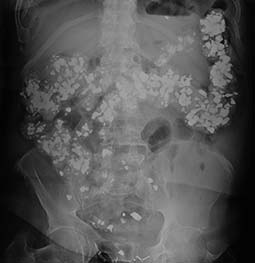
PICA is often diagnosed in a hospital emergency room, when the child or adolescent develops symptoms of lead poisoning, bowel perforation, or other medical complications caused by the non-food items that have been swallowed. However, it is very rarely reported as the chief complaint of the person. Therefore, eliciting history about pica is very important.
Laboratory studies may be used to assess these complications. The choice of imaging or laboratory studies depends on the characteristics of the ingested materials and the resultant medical problems.
Imaging studies
These are done to identify the ingested materials as well as to treat the gastrointestinal complications of pica:
- Abdominal x rays
- Barium studies of the upper and lower gastrointestinal (GI) tracts
- Upper GI endoscopy to diagnose the formation of bezoars (solid masses formed in the stomach) or to identify associated injuries to the digestive tract
The studies may be repeated at regular intervals to track changes in the location of ingested materials.
Blood examination
Blood tests will depend on the suspected causative factor as well as to determine the effects:
- A complete blood count will confirm or rule out anemia on the basis of haemoglobin levels and other parameters
- Screening for lead levels in blood in children is very important especially when they may have eaten paint or objects covered in lead-paint leading to lead poisoning.
- Tests for infection if the person has been eating contaminated soil or animal waste.
Stool examination
Stool examination is to be done to indicate presence or absence of worms or parasites.















